Advanced Financial Accounting Report: IFRS, Regulations, Valuation
VerifiedAdded on 2021/06/14
|11
|2701
|30
Report
AI Summary
This report provides a comprehensive analysis of advanced financial accounting principles, focusing on the International Financial Reporting Standards (IFRS) and asset revaluation. The report examines the qualitative characteristics of financial statements, highlighting the shortcomings of IFRS in accurately portraying a company's financial position due to a lack of relevance and faithful representation. It also discusses the implications of the Australian government's decision regarding social and environmental responsibilities, evaluating it through the lens of public interest theory, capture theory, and economic interest group theory of regulation. Furthermore, the report delves into the implications of the U.S. Financial Accounting Standards Board (FASB) Statement No. 144 on asset impairment and its impact on financial statements' relevance and faithful representation. Finally, the report explores the motivations behind directors' decisions not to revalue property, plant, and equipment, as well as the effects of such decisions on financial statements and shareholder wealth.
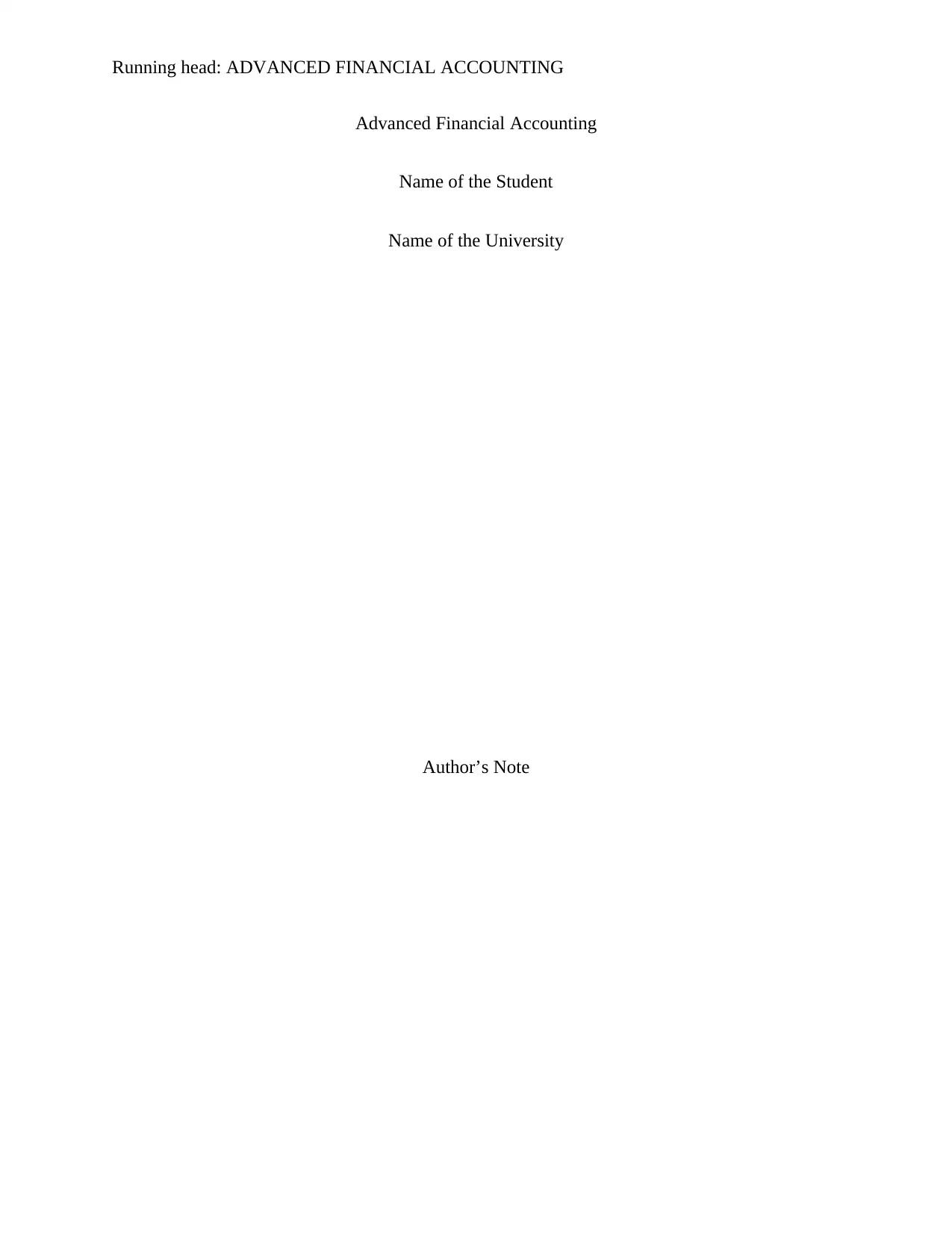
Running head: ADVANCED FINANCIAL ACCOUNTING
Advanced Financial Accounting
Name of the Student
Name of the University
Author’s Note
Advanced Financial Accounting
Name of the Student
Name of the University
Author’s Note
Paraphrase This Document
Need a fresh take? Get an instant paraphrase of this document with our AI Paraphraser
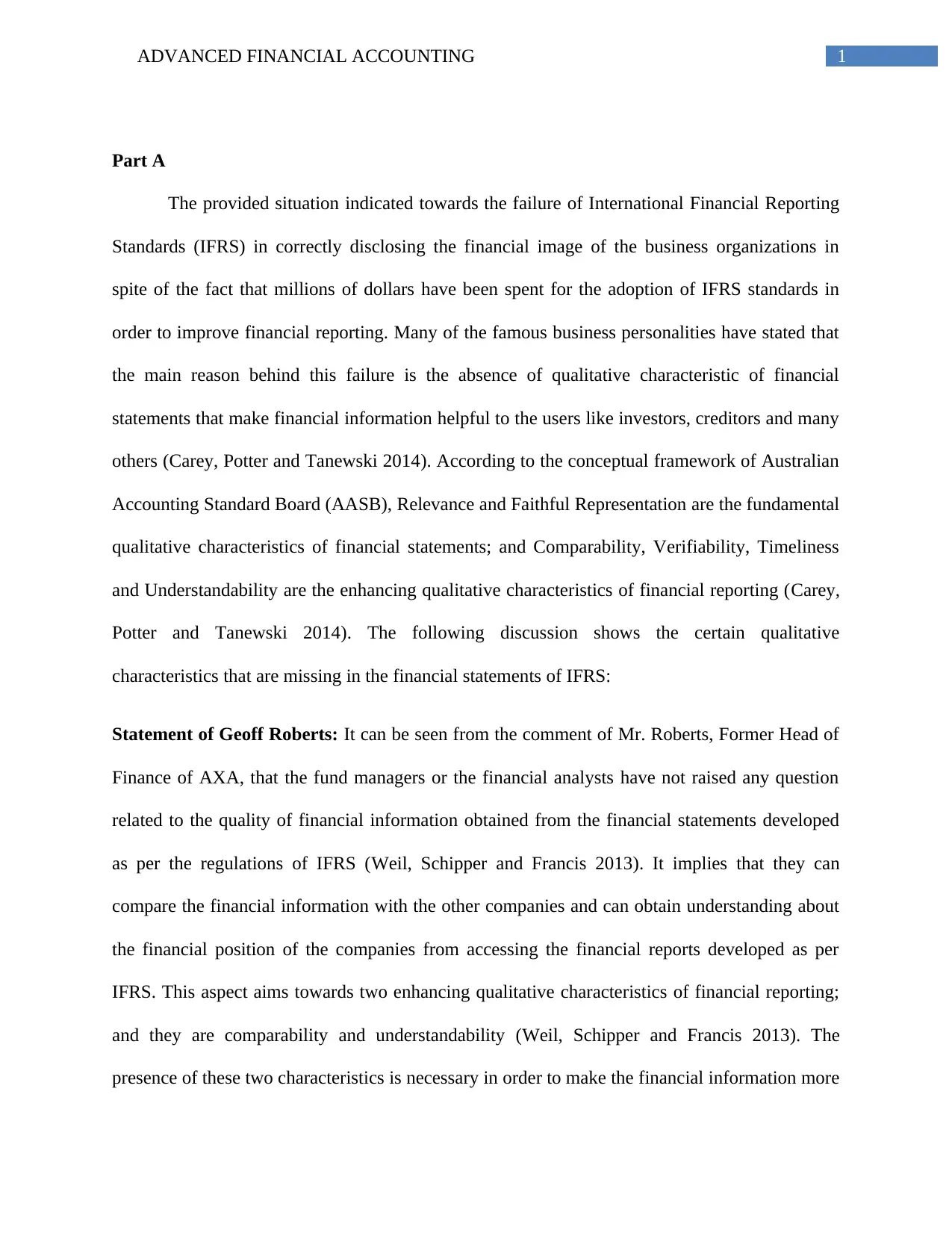
1ADVANCED FINANCIAL ACCOUNTING
Part A
The provided situation indicated towards the failure of International Financial Reporting
Standards (IFRS) in correctly disclosing the financial image of the business organizations in
spite of the fact that millions of dollars have been spent for the adoption of IFRS standards in
order to improve financial reporting. Many of the famous business personalities have stated that
the main reason behind this failure is the absence of qualitative characteristic of financial
statements that make financial information helpful to the users like investors, creditors and many
others (Carey, Potter and Tanewski 2014). According to the conceptual framework of Australian
Accounting Standard Board (AASB), Relevance and Faithful Representation are the fundamental
qualitative characteristics of financial statements; and Comparability, Verifiability, Timeliness
and Understandability are the enhancing qualitative characteristics of financial reporting (Carey,
Potter and Tanewski 2014). The following discussion shows the certain qualitative
characteristics that are missing in the financial statements of IFRS:
Statement of Geoff Roberts: It can be seen from the comment of Mr. Roberts, Former Head of
Finance of AXA, that the fund managers or the financial analysts have not raised any question
related to the quality of financial information obtained from the financial statements developed
as per the regulations of IFRS (Weil, Schipper and Francis 2013). It implies that they can
compare the financial information with the other companies and can obtain understanding about
the financial position of the companies from accessing the financial reports developed as per
IFRS. This aspect aims towards two enhancing qualitative characteristics of financial reporting;
and they are comparability and understandability (Weil, Schipper and Francis 2013). The
presence of these two characteristics is necessary in order to make the financial information more
Part A
The provided situation indicated towards the failure of International Financial Reporting
Standards (IFRS) in correctly disclosing the financial image of the business organizations in
spite of the fact that millions of dollars have been spent for the adoption of IFRS standards in
order to improve financial reporting. Many of the famous business personalities have stated that
the main reason behind this failure is the absence of qualitative characteristic of financial
statements that make financial information helpful to the users like investors, creditors and many
others (Carey, Potter and Tanewski 2014). According to the conceptual framework of Australian
Accounting Standard Board (AASB), Relevance and Faithful Representation are the fundamental
qualitative characteristics of financial statements; and Comparability, Verifiability, Timeliness
and Understandability are the enhancing qualitative characteristics of financial reporting (Carey,
Potter and Tanewski 2014). The following discussion shows the certain qualitative
characteristics that are missing in the financial statements of IFRS:
Statement of Geoff Roberts: It can be seen from the comment of Mr. Roberts, Former Head of
Finance of AXA, that the fund managers or the financial analysts have not raised any question
related to the quality of financial information obtained from the financial statements developed
as per the regulations of IFRS (Weil, Schipper and Francis 2013). It implies that they can
compare the financial information with the other companies and can obtain understanding about
the financial position of the companies from accessing the financial reports developed as per
IFRS. This aspect aims towards two enhancing qualitative characteristics of financial reporting;
and they are comparability and understandability (Weil, Schipper and Francis 2013). The
presence of these two characteristics is necessary in order to make the financial information more
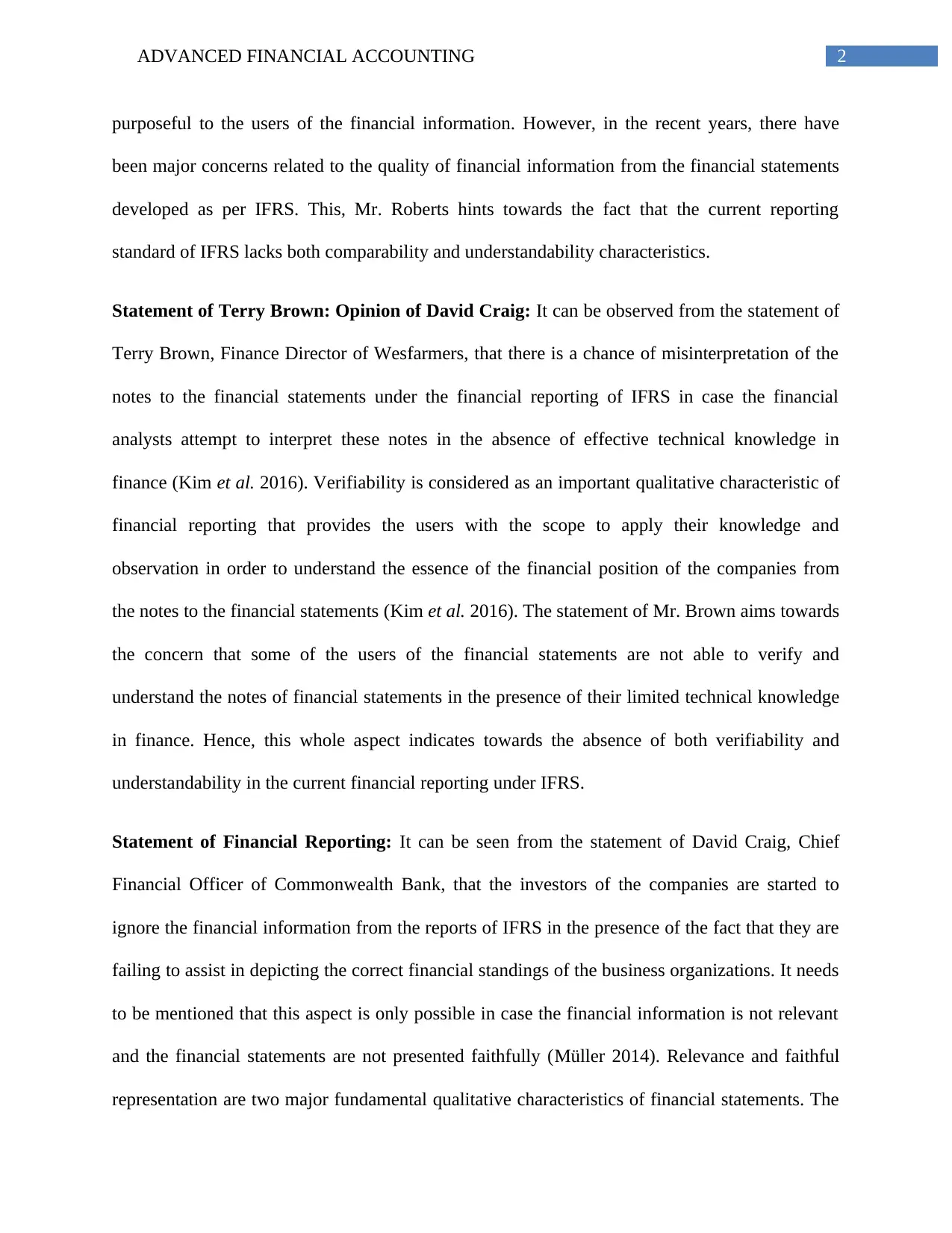
2ADVANCED FINANCIAL ACCOUNTING
purposeful to the users of the financial information. However, in the recent years, there have
been major concerns related to the quality of financial information from the financial statements
developed as per IFRS. This, Mr. Roberts hints towards the fact that the current reporting
standard of IFRS lacks both comparability and understandability characteristics.
Statement of Terry Brown: Opinion of David Craig: It can be observed from the statement of
Terry Brown, Finance Director of Wesfarmers, that there is a chance of misinterpretation of the
notes to the financial statements under the financial reporting of IFRS in case the financial
analysts attempt to interpret these notes in the absence of effective technical knowledge in
finance (Kim et al. 2016). Verifiability is considered as an important qualitative characteristic of
financial reporting that provides the users with the scope to apply their knowledge and
observation in order to understand the essence of the financial position of the companies from
the notes to the financial statements (Kim et al. 2016). The statement of Mr. Brown aims towards
the concern that some of the users of the financial statements are not able to verify and
understand the notes of financial statements in the presence of their limited technical knowledge
in finance. Hence, this whole aspect indicates towards the absence of both verifiability and
understandability in the current financial reporting under IFRS.
Statement of Financial Reporting: It can be seen from the statement of David Craig, Chief
Financial Officer of Commonwealth Bank, that the investors of the companies are started to
ignore the financial information from the reports of IFRS in the presence of the fact that they are
failing to assist in depicting the correct financial standings of the business organizations. It needs
to be mentioned that this aspect is only possible in case the financial information is not relevant
and the financial statements are not presented faithfully (Müller 2014). Relevance and faithful
representation are two major fundamental qualitative characteristics of financial statements. The
purposeful to the users of the financial information. However, in the recent years, there have
been major concerns related to the quality of financial information from the financial statements
developed as per IFRS. This, Mr. Roberts hints towards the fact that the current reporting
standard of IFRS lacks both comparability and understandability characteristics.
Statement of Terry Brown: Opinion of David Craig: It can be observed from the statement of
Terry Brown, Finance Director of Wesfarmers, that there is a chance of misinterpretation of the
notes to the financial statements under the financial reporting of IFRS in case the financial
analysts attempt to interpret these notes in the absence of effective technical knowledge in
finance (Kim et al. 2016). Verifiability is considered as an important qualitative characteristic of
financial reporting that provides the users with the scope to apply their knowledge and
observation in order to understand the essence of the financial position of the companies from
the notes to the financial statements (Kim et al. 2016). The statement of Mr. Brown aims towards
the concern that some of the users of the financial statements are not able to verify and
understand the notes of financial statements in the presence of their limited technical knowledge
in finance. Hence, this whole aspect indicates towards the absence of both verifiability and
understandability in the current financial reporting under IFRS.
Statement of Financial Reporting: It can be seen from the statement of David Craig, Chief
Financial Officer of Commonwealth Bank, that the investors of the companies are started to
ignore the financial information from the reports of IFRS in the presence of the fact that they are
failing to assist in depicting the correct financial standings of the business organizations. It needs
to be mentioned that this aspect is only possible in case the financial information is not relevant
and the financial statements are not presented faithfully (Müller 2014). Relevance and faithful
representation are two major fundamental qualitative characteristics of financial statements. The
⊘ This is a preview!⊘
Do you want full access?
Subscribe today to unlock all pages.

Trusted by 1+ million students worldwide
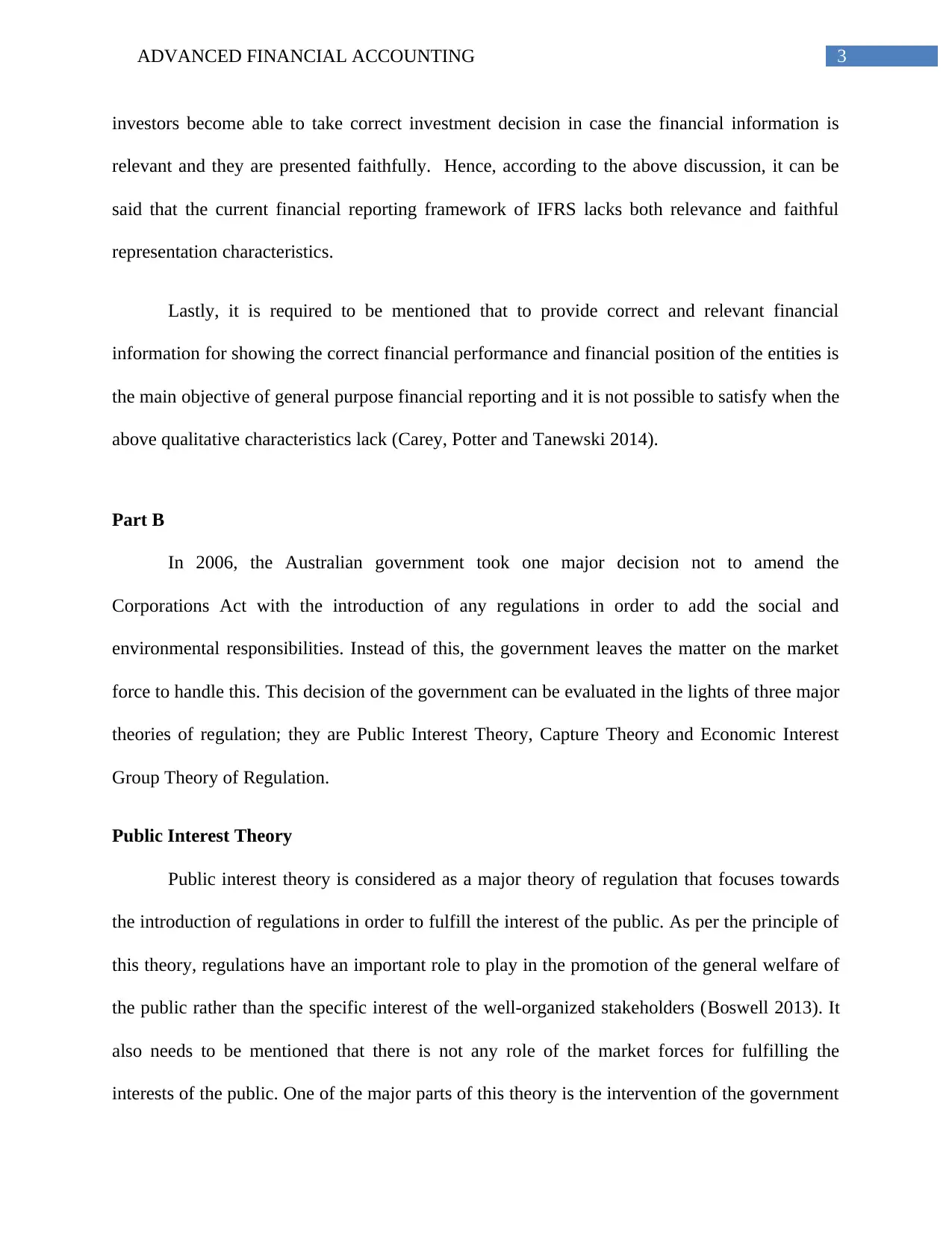
3ADVANCED FINANCIAL ACCOUNTING
investors become able to take correct investment decision in case the financial information is
relevant and they are presented faithfully. Hence, according to the above discussion, it can be
said that the current financial reporting framework of IFRS lacks both relevance and faithful
representation characteristics.
Lastly, it is required to be mentioned that to provide correct and relevant financial
information for showing the correct financial performance and financial position of the entities is
the main objective of general purpose financial reporting and it is not possible to satisfy when the
above qualitative characteristics lack (Carey, Potter and Tanewski 2014).
Part B
In 2006, the Australian government took one major decision not to amend the
Corporations Act with the introduction of any regulations in order to add the social and
environmental responsibilities. Instead of this, the government leaves the matter on the market
force to handle this. This decision of the government can be evaluated in the lights of three major
theories of regulation; they are Public Interest Theory, Capture Theory and Economic Interest
Group Theory of Regulation.
Public Interest Theory
Public interest theory is considered as a major theory of regulation that focuses towards
the introduction of regulations in order to fulfill the interest of the public. As per the principle of
this theory, regulations have an important role to play in the promotion of the general welfare of
the public rather than the specific interest of the well-organized stakeholders (Boswell 2013). It
also needs to be mentioned that there is not any role of the market forces for fulfilling the
interests of the public. One of the major parts of this theory is the intervention of the government
investors become able to take correct investment decision in case the financial information is
relevant and they are presented faithfully. Hence, according to the above discussion, it can be
said that the current financial reporting framework of IFRS lacks both relevance and faithful
representation characteristics.
Lastly, it is required to be mentioned that to provide correct and relevant financial
information for showing the correct financial performance and financial position of the entities is
the main objective of general purpose financial reporting and it is not possible to satisfy when the
above qualitative characteristics lack (Carey, Potter and Tanewski 2014).
Part B
In 2006, the Australian government took one major decision not to amend the
Corporations Act with the introduction of any regulations in order to add the social and
environmental responsibilities. Instead of this, the government leaves the matter on the market
force to handle this. This decision of the government can be evaluated in the lights of three major
theories of regulation; they are Public Interest Theory, Capture Theory and Economic Interest
Group Theory of Regulation.
Public Interest Theory
Public interest theory is considered as a major theory of regulation that focuses towards
the introduction of regulations in order to fulfill the interest of the public. As per the principle of
this theory, regulations have an important role to play in the promotion of the general welfare of
the public rather than the specific interest of the well-organized stakeholders (Boswell 2013). It
also needs to be mentioned that there is not any role of the market forces for fulfilling the
interests of the public. One of the major parts of this theory is the intervention of the government
Paraphrase This Document
Need a fresh take? Get an instant paraphrase of this document with our AI Paraphraser
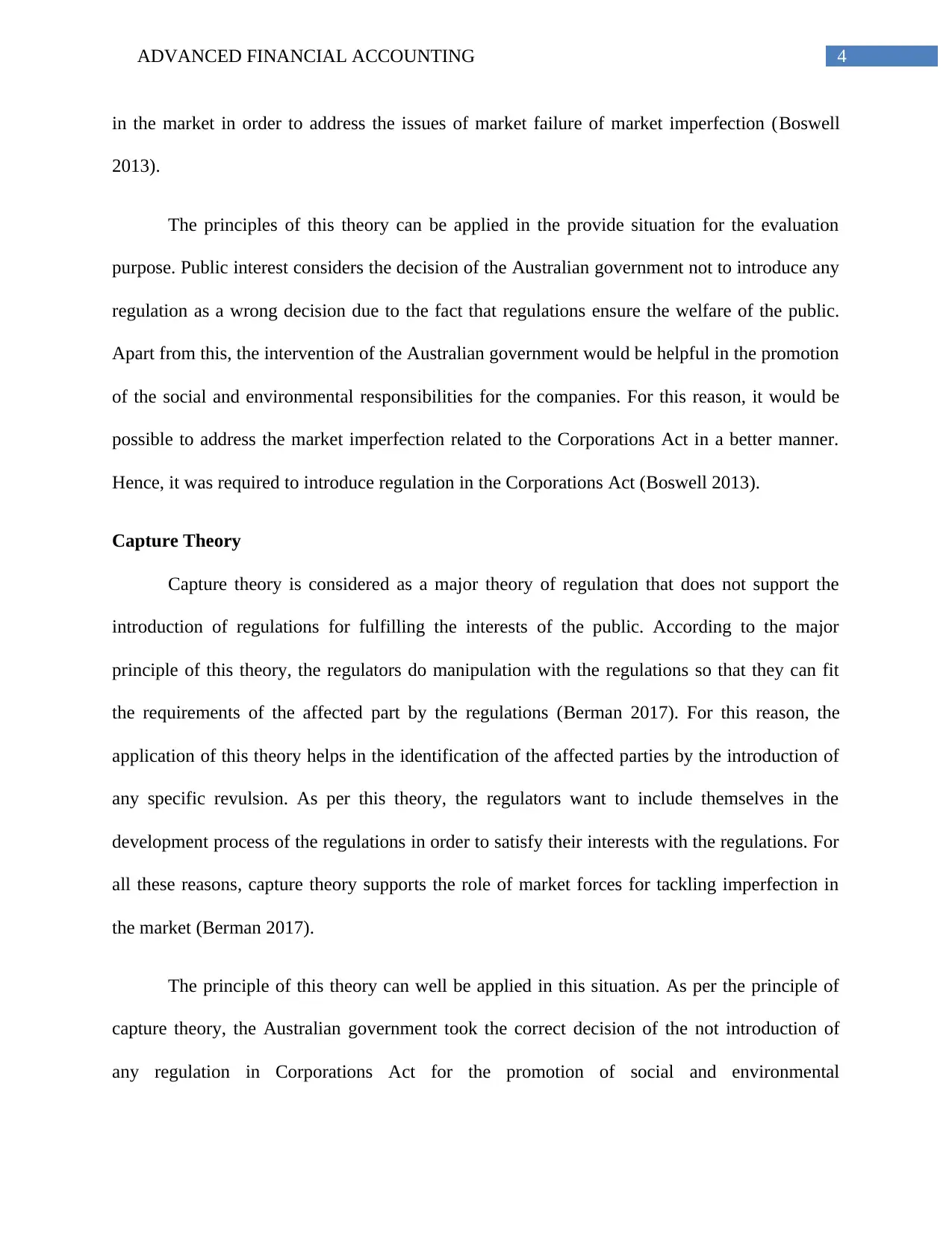
4ADVANCED FINANCIAL ACCOUNTING
in the market in order to address the issues of market failure of market imperfection (Boswell
2013).
The principles of this theory can be applied in the provide situation for the evaluation
purpose. Public interest considers the decision of the Australian government not to introduce any
regulation as a wrong decision due to the fact that regulations ensure the welfare of the public.
Apart from this, the intervention of the Australian government would be helpful in the promotion
of the social and environmental responsibilities for the companies. For this reason, it would be
possible to address the market imperfection related to the Corporations Act in a better manner.
Hence, it was required to introduce regulation in the Corporations Act (Boswell 2013).
Capture Theory
Capture theory is considered as a major theory of regulation that does not support the
introduction of regulations for fulfilling the interests of the public. According to the major
principle of this theory, the regulators do manipulation with the regulations so that they can fit
the requirements of the affected part by the regulations (Berman 2017). For this reason, the
application of this theory helps in the identification of the affected parties by the introduction of
any specific revulsion. As per this theory, the regulators want to include themselves in the
development process of the regulations in order to satisfy their interests with the regulations. For
all these reasons, capture theory supports the role of market forces for tackling imperfection in
the market (Berman 2017).
The principle of this theory can well be applied in this situation. As per the principle of
capture theory, the Australian government took the correct decision of the not introduction of
any regulation in Corporations Act for the promotion of social and environmental
in the market in order to address the issues of market failure of market imperfection (Boswell
2013).
The principles of this theory can be applied in the provide situation for the evaluation
purpose. Public interest considers the decision of the Australian government not to introduce any
regulation as a wrong decision due to the fact that regulations ensure the welfare of the public.
Apart from this, the intervention of the Australian government would be helpful in the promotion
of the social and environmental responsibilities for the companies. For this reason, it would be
possible to address the market imperfection related to the Corporations Act in a better manner.
Hence, it was required to introduce regulation in the Corporations Act (Boswell 2013).
Capture Theory
Capture theory is considered as a major theory of regulation that does not support the
introduction of regulations for fulfilling the interests of the public. According to the major
principle of this theory, the regulators do manipulation with the regulations so that they can fit
the requirements of the affected part by the regulations (Berman 2017). For this reason, the
application of this theory helps in the identification of the affected parties by the introduction of
any specific revulsion. As per this theory, the regulators want to include themselves in the
development process of the regulations in order to satisfy their interests with the regulations. For
all these reasons, capture theory supports the role of market forces for tackling imperfection in
the market (Berman 2017).
The principle of this theory can well be applied in this situation. As per the principle of
capture theory, the Australian government took the correct decision of the not introduction of
any regulation in Corporations Act for the promotion of social and environmental

5ADVANCED FINANCIAL ACCOUNTING
responsibilities. In the absence of any regulation, there will not be any opportunity for the
regulators to use the regulations in order to satisfy their interests (Berman 2017). In the absence
of any regulation, the market forces will be active to fulfill the social and environmental
responsibilities.
Economic Interest Group Theory of Regulation
Another major theory of regulation is the economic interest group theory of regulation.
This theory indicates towards the fact that the industries are the developers of the regulations and
the main aim behind the development of regulation is to make the industries advantageous. This
theory can be applied in the present situation (Seidman 2016). Thus, as per this theory, it was
required for the Australian government to introduce regulation in the Corporations Act for the
industries. The introduction of this regulation would put an obligation on the business industries
to comply with the regulations of social and environmental responsibilities.
Part C
As per the United States, Financial Accounting Standard Board (FASB) Statement No.
144 Accounting for Impairment or Disposal of Long-Lived Assets, there is not any requirement
for the US business entities to do the revaluation of their non-current assets based on fair value;
but the requirement is to take into consideration the impairment costs that is associated with
those non-current assets (Paik and Lee 2013). This particular regulation has some major
implications related to the relevance and faithful representation of the US corporate financial
statements and they are discussed below
1. With the assistance of the above-mentioned regulation for asset revaluation, it is possible
for the users of the financial information to identify the major differences as well as the
responsibilities. In the absence of any regulation, there will not be any opportunity for the
regulators to use the regulations in order to satisfy their interests (Berman 2017). In the absence
of any regulation, the market forces will be active to fulfill the social and environmental
responsibilities.
Economic Interest Group Theory of Regulation
Another major theory of regulation is the economic interest group theory of regulation.
This theory indicates towards the fact that the industries are the developers of the regulations and
the main aim behind the development of regulation is to make the industries advantageous. This
theory can be applied in the present situation (Seidman 2016). Thus, as per this theory, it was
required for the Australian government to introduce regulation in the Corporations Act for the
industries. The introduction of this regulation would put an obligation on the business industries
to comply with the regulations of social and environmental responsibilities.
Part C
As per the United States, Financial Accounting Standard Board (FASB) Statement No.
144 Accounting for Impairment or Disposal of Long-Lived Assets, there is not any requirement
for the US business entities to do the revaluation of their non-current assets based on fair value;
but the requirement is to take into consideration the impairment costs that is associated with
those non-current assets (Paik and Lee 2013). This particular regulation has some major
implications related to the relevance and faithful representation of the US corporate financial
statements and they are discussed below
1. With the assistance of the above-mentioned regulation for asset revaluation, it is possible
for the users of the financial information to identify the major differences as well as the
⊘ This is a preview!⊘
Do you want full access?
Subscribe today to unlock all pages.

Trusted by 1+ million students worldwide
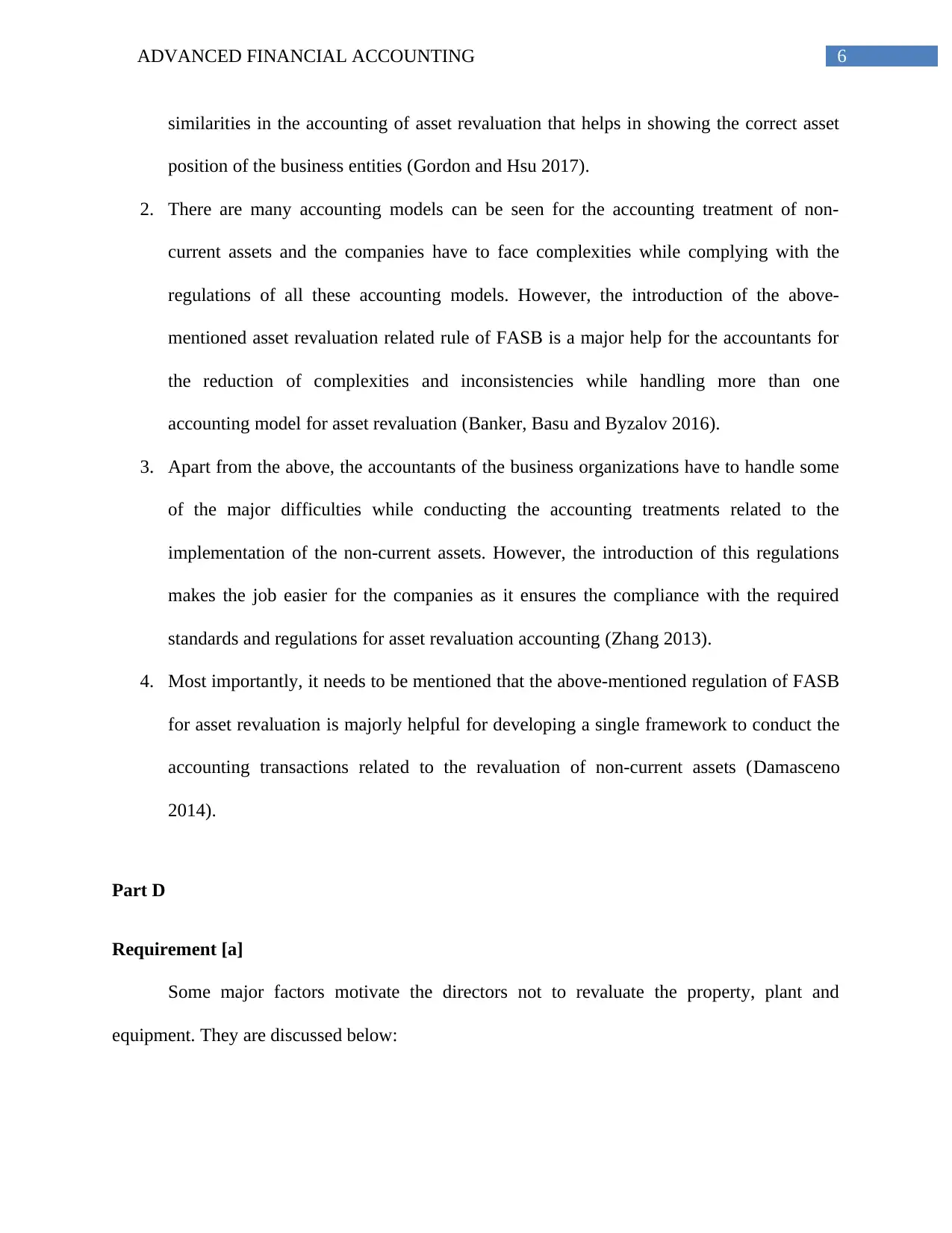
6ADVANCED FINANCIAL ACCOUNTING
similarities in the accounting of asset revaluation that helps in showing the correct asset
position of the business entities (Gordon and Hsu 2017).
2. There are many accounting models can be seen for the accounting treatment of non-
current assets and the companies have to face complexities while complying with the
regulations of all these accounting models. However, the introduction of the above-
mentioned asset revaluation related rule of FASB is a major help for the accountants for
the reduction of complexities and inconsistencies while handling more than one
accounting model for asset revaluation (Banker, Basu and Byzalov 2016).
3. Apart from the above, the accountants of the business organizations have to handle some
of the major difficulties while conducting the accounting treatments related to the
implementation of the non-current assets. However, the introduction of this regulations
makes the job easier for the companies as it ensures the compliance with the required
standards and regulations for asset revaluation accounting (Zhang 2013).
4. Most importantly, it needs to be mentioned that the above-mentioned regulation of FASB
for asset revaluation is majorly helpful for developing a single framework to conduct the
accounting transactions related to the revaluation of non-current assets (Damasceno
2014).
Part D
Requirement [a]
Some major factors motivate the directors not to revaluate the property, plant and
equipment. They are discussed below:
similarities in the accounting of asset revaluation that helps in showing the correct asset
position of the business entities (Gordon and Hsu 2017).
2. There are many accounting models can be seen for the accounting treatment of non-
current assets and the companies have to face complexities while complying with the
regulations of all these accounting models. However, the introduction of the above-
mentioned asset revaluation related rule of FASB is a major help for the accountants for
the reduction of complexities and inconsistencies while handling more than one
accounting model for asset revaluation (Banker, Basu and Byzalov 2016).
3. Apart from the above, the accountants of the business organizations have to handle some
of the major difficulties while conducting the accounting treatments related to the
implementation of the non-current assets. However, the introduction of this regulations
makes the job easier for the companies as it ensures the compliance with the required
standards and regulations for asset revaluation accounting (Zhang 2013).
4. Most importantly, it needs to be mentioned that the above-mentioned regulation of FASB
for asset revaluation is majorly helpful for developing a single framework to conduct the
accounting transactions related to the revaluation of non-current assets (Damasceno
2014).
Part D
Requirement [a]
Some major factors motivate the directors not to revaluate the property, plant and
equipment. They are discussed below:
Paraphrase This Document
Need a fresh take? Get an instant paraphrase of this document with our AI Paraphraser
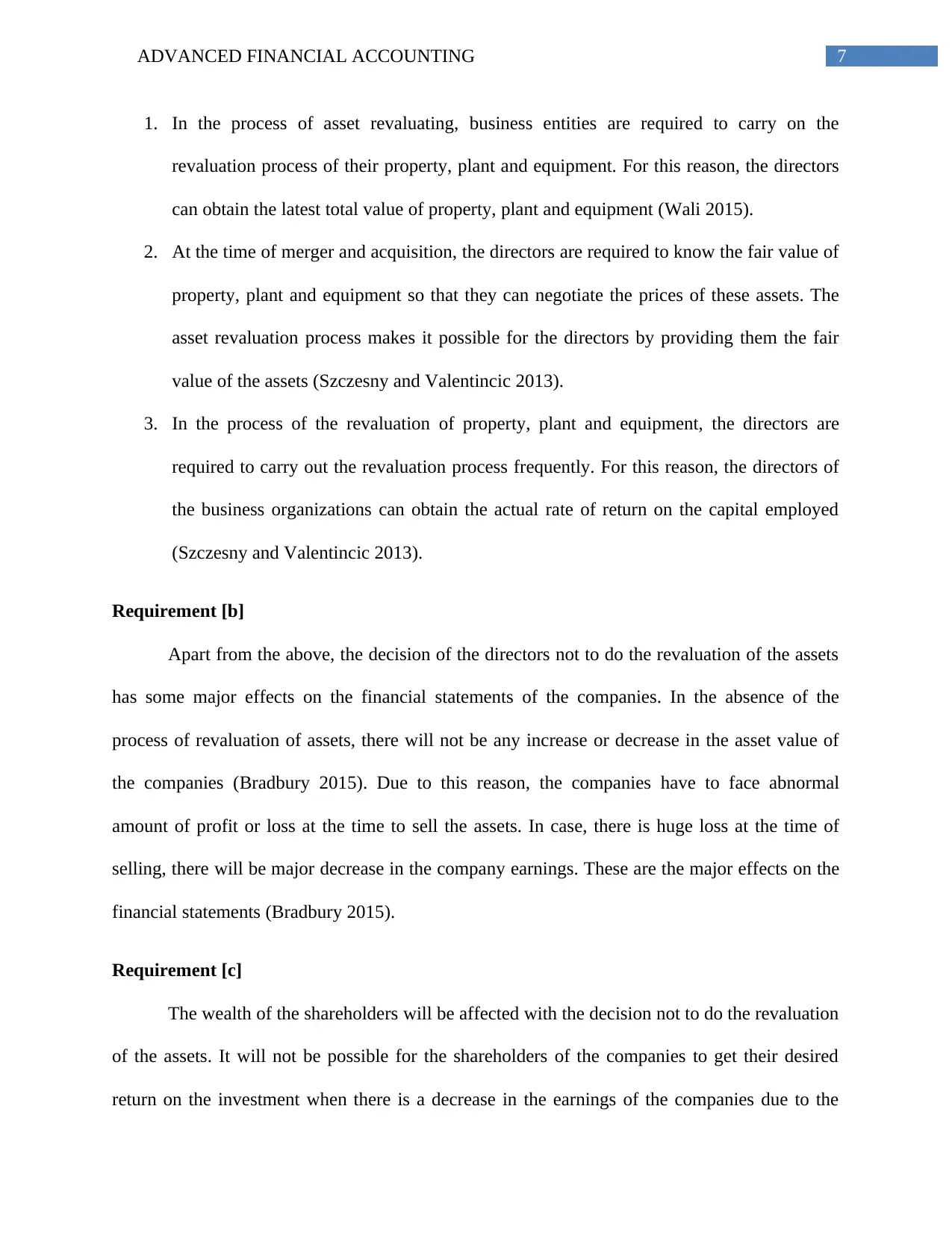
7ADVANCED FINANCIAL ACCOUNTING
1. In the process of asset revaluating, business entities are required to carry on the
revaluation process of their property, plant and equipment. For this reason, the directors
can obtain the latest total value of property, plant and equipment (Wali 2015).
2. At the time of merger and acquisition, the directors are required to know the fair value of
property, plant and equipment so that they can negotiate the prices of these assets. The
asset revaluation process makes it possible for the directors by providing them the fair
value of the assets (Szczesny and Valentincic 2013).
3. In the process of the revaluation of property, plant and equipment, the directors are
required to carry out the revaluation process frequently. For this reason, the directors of
the business organizations can obtain the actual rate of return on the capital employed
(Szczesny and Valentincic 2013).
Requirement [b]
Apart from the above, the decision of the directors not to do the revaluation of the assets
has some major effects on the financial statements of the companies. In the absence of the
process of revaluation of assets, there will not be any increase or decrease in the asset value of
the companies (Bradbury 2015). Due to this reason, the companies have to face abnormal
amount of profit or loss at the time to sell the assets. In case, there is huge loss at the time of
selling, there will be major decrease in the company earnings. These are the major effects on the
financial statements (Bradbury 2015).
Requirement [c]
The wealth of the shareholders will be affected with the decision not to do the revaluation
of the assets. It will not be possible for the shareholders of the companies to get their desired
return on the investment when there is a decrease in the earnings of the companies due to the
1. In the process of asset revaluating, business entities are required to carry on the
revaluation process of their property, plant and equipment. For this reason, the directors
can obtain the latest total value of property, plant and equipment (Wali 2015).
2. At the time of merger and acquisition, the directors are required to know the fair value of
property, plant and equipment so that they can negotiate the prices of these assets. The
asset revaluation process makes it possible for the directors by providing them the fair
value of the assets (Szczesny and Valentincic 2013).
3. In the process of the revaluation of property, plant and equipment, the directors are
required to carry out the revaluation process frequently. For this reason, the directors of
the business organizations can obtain the actual rate of return on the capital employed
(Szczesny and Valentincic 2013).
Requirement [b]
Apart from the above, the decision of the directors not to do the revaluation of the assets
has some major effects on the financial statements of the companies. In the absence of the
process of revaluation of assets, there will not be any increase or decrease in the asset value of
the companies (Bradbury 2015). Due to this reason, the companies have to face abnormal
amount of profit or loss at the time to sell the assets. In case, there is huge loss at the time of
selling, there will be major decrease in the company earnings. These are the major effects on the
financial statements (Bradbury 2015).
Requirement [c]
The wealth of the shareholders will be affected with the decision not to do the revaluation
of the assets. It will not be possible for the shareholders of the companies to get their desired
return on the investment when there is a decrease in the earnings of the companies due to the

8ADVANCED FINANCIAL ACCOUNTING
absence in the asset revaluation process. For this reason, there will be decrease in total wealth of
the shareholders (Choi et al. 2013).
absence in the asset revaluation process. For this reason, there will be decrease in total wealth of
the shareholders (Choi et al. 2013).
⊘ This is a preview!⊘
Do you want full access?
Subscribe today to unlock all pages.

Trusted by 1+ million students worldwide
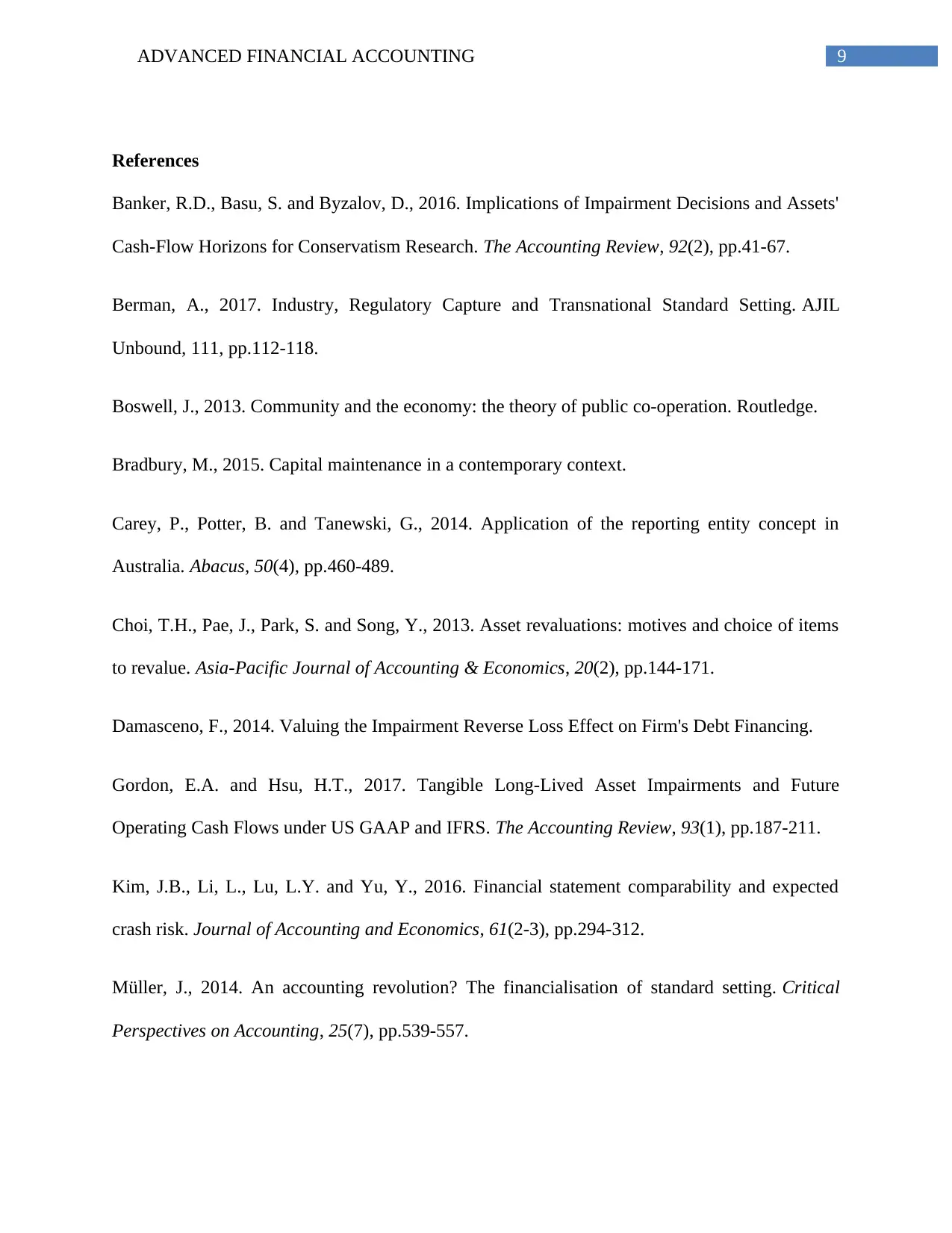
9ADVANCED FINANCIAL ACCOUNTING
References
Banker, R.D., Basu, S. and Byzalov, D., 2016. Implications of Impairment Decisions and Assets'
Cash-Flow Horizons for Conservatism Research. The Accounting Review, 92(2), pp.41-67.
Berman, A., 2017. Industry, Regulatory Capture and Transnational Standard Setting. AJIL
Unbound, 111, pp.112-118.
Boswell, J., 2013. Community and the economy: the theory of public co-operation. Routledge.
Bradbury, M., 2015. Capital maintenance in a contemporary context.
Carey, P., Potter, B. and Tanewski, G., 2014. Application of the reporting entity concept in
Australia. Abacus, 50(4), pp.460-489.
Choi, T.H., Pae, J., Park, S. and Song, Y., 2013. Asset revaluations: motives and choice of items
to revalue. Asia-Pacific Journal of Accounting & Economics, 20(2), pp.144-171.
Damasceno, F., 2014. Valuing the Impairment Reverse Loss Effect on Firm's Debt Financing.
Gordon, E.A. and Hsu, H.T., 2017. Tangible Long-Lived Asset Impairments and Future
Operating Cash Flows under US GAAP and IFRS. The Accounting Review, 93(1), pp.187-211.
Kim, J.B., Li, L., Lu, L.Y. and Yu, Y., 2016. Financial statement comparability and expected
crash risk. Journal of Accounting and Economics, 61(2-3), pp.294-312.
Müller, J., 2014. An accounting revolution? The financialisation of standard setting. Critical
Perspectives on Accounting, 25(7), pp.539-557.
References
Banker, R.D., Basu, S. and Byzalov, D., 2016. Implications of Impairment Decisions and Assets'
Cash-Flow Horizons for Conservatism Research. The Accounting Review, 92(2), pp.41-67.
Berman, A., 2017. Industry, Regulatory Capture and Transnational Standard Setting. AJIL
Unbound, 111, pp.112-118.
Boswell, J., 2013. Community and the economy: the theory of public co-operation. Routledge.
Bradbury, M., 2015. Capital maintenance in a contemporary context.
Carey, P., Potter, B. and Tanewski, G., 2014. Application of the reporting entity concept in
Australia. Abacus, 50(4), pp.460-489.
Choi, T.H., Pae, J., Park, S. and Song, Y., 2013. Asset revaluations: motives and choice of items
to revalue. Asia-Pacific Journal of Accounting & Economics, 20(2), pp.144-171.
Damasceno, F., 2014. Valuing the Impairment Reverse Loss Effect on Firm's Debt Financing.
Gordon, E.A. and Hsu, H.T., 2017. Tangible Long-Lived Asset Impairments and Future
Operating Cash Flows under US GAAP and IFRS. The Accounting Review, 93(1), pp.187-211.
Kim, J.B., Li, L., Lu, L.Y. and Yu, Y., 2016. Financial statement comparability and expected
crash risk. Journal of Accounting and Economics, 61(2-3), pp.294-312.
Müller, J., 2014. An accounting revolution? The financialisation of standard setting. Critical
Perspectives on Accounting, 25(7), pp.539-557.
Paraphrase This Document
Need a fresh take? Get an instant paraphrase of this document with our AI Paraphraser
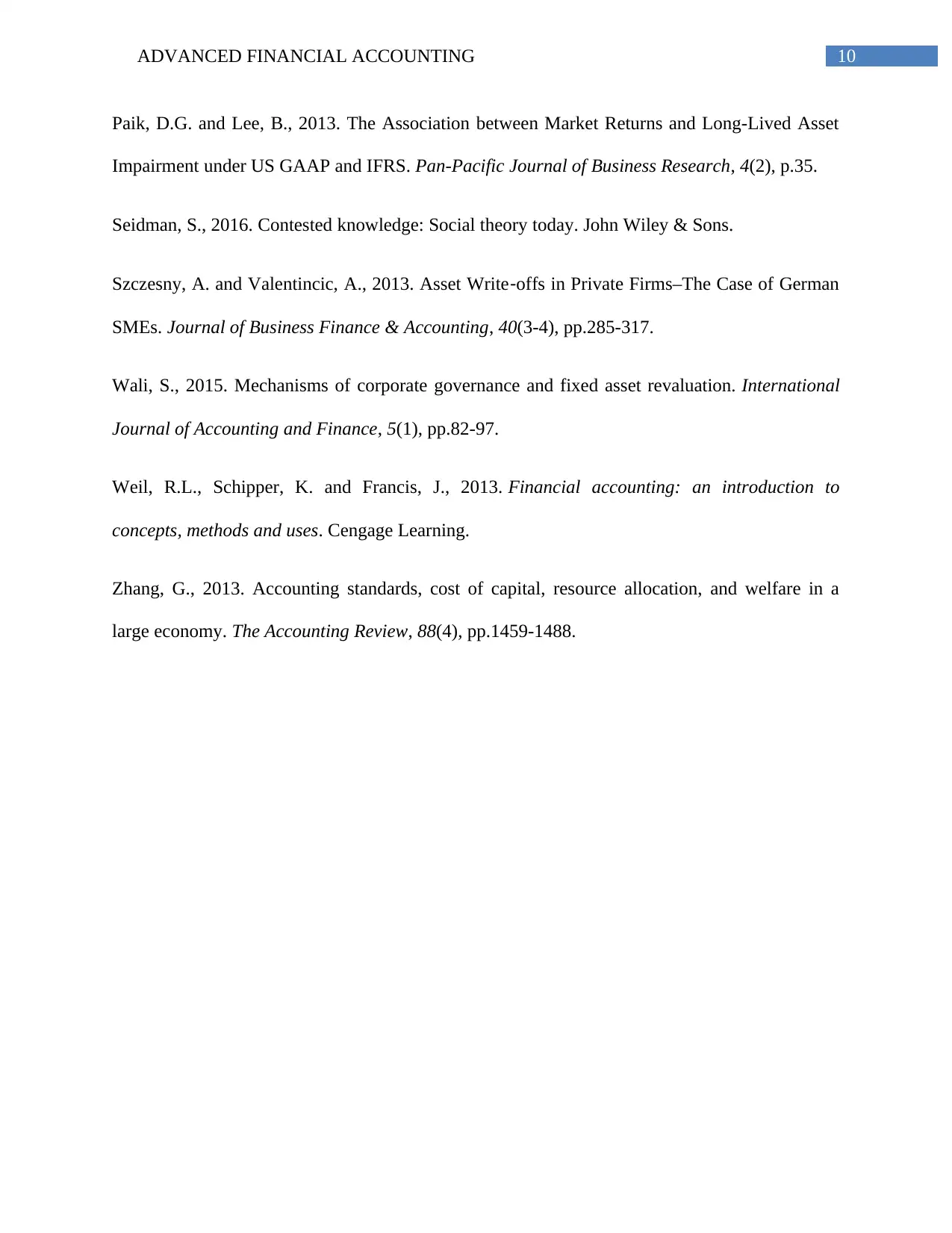
10ADVANCED FINANCIAL ACCOUNTING
Paik, D.G. and Lee, B., 2013. The Association between Market Returns and Long-Lived Asset
Impairment under US GAAP and IFRS. Pan-Pacific Journal of Business Research, 4(2), p.35.
Seidman, S., 2016. Contested knowledge: Social theory today. John Wiley & Sons.
Szczesny, A. and Valentincic, A., 2013. Asset Write‐offs in Private Firms–The Case of German
SMEs. Journal of Business Finance & Accounting, 40(3-4), pp.285-317.
Wali, S., 2015. Mechanisms of corporate governance and fixed asset revaluation. International
Journal of Accounting and Finance, 5(1), pp.82-97.
Weil, R.L., Schipper, K. and Francis, J., 2013. Financial accounting: an introduction to
concepts, methods and uses. Cengage Learning.
Zhang, G., 2013. Accounting standards, cost of capital, resource allocation, and welfare in a
large economy. The Accounting Review, 88(4), pp.1459-1488.
Paik, D.G. and Lee, B., 2013. The Association between Market Returns and Long-Lived Asset
Impairment under US GAAP and IFRS. Pan-Pacific Journal of Business Research, 4(2), p.35.
Seidman, S., 2016. Contested knowledge: Social theory today. John Wiley & Sons.
Szczesny, A. and Valentincic, A., 2013. Asset Write‐offs in Private Firms–The Case of German
SMEs. Journal of Business Finance & Accounting, 40(3-4), pp.285-317.
Wali, S., 2015. Mechanisms of corporate governance and fixed asset revaluation. International
Journal of Accounting and Finance, 5(1), pp.82-97.
Weil, R.L., Schipper, K. and Francis, J., 2013. Financial accounting: an introduction to
concepts, methods and uses. Cengage Learning.
Zhang, G., 2013. Accounting standards, cost of capital, resource allocation, and welfare in a
large economy. The Accounting Review, 88(4), pp.1459-1488.
1 out of 11
Related Documents
Your All-in-One AI-Powered Toolkit for Academic Success.
+13062052269
info@desklib.com
Available 24*7 on WhatsApp / Email
![[object Object]](/_next/static/media/star-bottom.7253800d.svg)
Unlock your academic potential
Copyright © 2020–2025 A2Z Services. All Rights Reserved. Developed and managed by ZUCOL.





